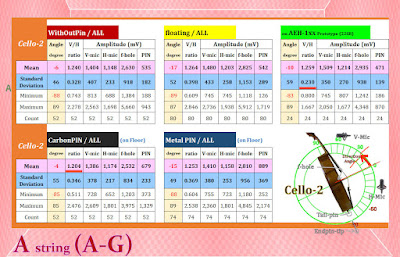[ 2/15/2020 ] Labels: 72.Resonance Direction-A
(1)The ratio between amplitude of vertical mic and horizontal mic('V/H-Ratio') was compared by each endpin groups and 'without pin'. V/H-Ratio probably represents a barometer of where the resonance center of a cello is. Then all data of resonance direction from CELLO-1 were heaped in a chart.
CELLO-1 is a young 8-year-old cello, probably composed of rather flexible wood plates, seems taking a various directional resonance even in a single semitone : A#, C, D, D#, E, G on A string. The result of this observation recalls 'uncertainty' in resonance, however this also means to have a risk to be easily impacted by external conditions such as equipment of endpins.
[ 2/19/2020 ]
‘uncertainty’ in resonance direction will be revised as ‘rotating’ in our future posts.
(2)V/H-ratio data from 'without pin' and 'floating' shows us a CELLO-1's unique feature, each semitone might have a favorite resonance position in the cello body instead of resonance direction.
This pattern was easily lost by being equipped an endpin and by leveling the V/H-ratio. There is an another finding in 'on floor' data: The disparity in V/H-ratio becomes greater at 'on floor' case. It might also suggest the resonant center of body are shifted to upper(or lower) point.
(3)AEH(Advanced Endpin Holder) seems mitigating the side-effects from an endpin, although the data counts are limited.
(4)At the very end of CELLO-1 study on A string, let's take a look at two typical oscilloscope charts of C#(period: 3.5** mS). At 'without Pin' case, there observed 2 or 3 mixed beats in a period, and something irregular 2 beats on the tail-pin instead, and 6 beats existed at H-mic. On the other hand at 'on floor' case, endpin is acting as a clear mechanical 3 beats, and corresponding upper body(V-mic) and f-hole resonance are taking clear 2 beats, then as a consequence lower body(H-mic) is driven to a flat single beat accompanied with tiny oscillations. These phenomena probably relate to the declined averaged amplitude(at H-mic) in the former report.
(1)Cello1のA線上の各音について、垂直(V)方向マイクと水平(H)方向マイクの振幅比をエンドピン(有無)各グループで比較した。V/H比はおそらくチェロ胴体の上部で共鳴が強いか下部で強いかを反映していると思われる。さらに、CELLO-1の全ての測定データの共鳴方向を1つのグラフに集めてみた。
CELLO-1 は製作されて8年の若いチェロである。先回の投稿データと合わせてこの楽器の特徴を記述するとすれば、一つの音の中でも様々な共鳴方向を取っているように見える。たとえば A#, C, D, D#, E, G音 では胴体の輪切り方向から身長方向まで360°自由にとっているようだ。極端に言うとどの方向に共鳴するかは不定であり、いろいろな環境により逆に 敏感に影響されることを意味している。しかしその代わり、各音ごとに共鳴するお好みの場所があることも示している。
(2)「ピン無」と「ピン有・浮遊」で V/Hパターンが極めて良く似ている。「床置き」するとそのパターンが失われ、パターンの平均化が行われ、同時に V/H比の平均値も増加している。(先回報告の、エンドピン共鳴がおこり H方向の振幅が低下していることと一致する。) また、V/H比の範囲も広がっている。つまり、極端化が増加していることを意味する。
(3)測定データが少ないので正確な判断は難しいが、AEHは、「ピン無し」と「床置き」との中間的な状態を作り、床置きの副作用をよく低減しているように見える。
(4)典型的な測定データサンプルを見てみよう。ピン無しの C# データでは、V方向マイクでは2ビートと3ビートが混ざったような振動波形をしている。テールピン ではちょっと変則的な2ピートである。その結果、Hマイク(胴体下部)では6ビートを刻み、f孔内音も全体を合算したような振動となっている。
一方、チタンエンドピンの床置きデータでは、エンドピンが明確な機械的な3ビートを取り、対応するかのように胴体上部(V)とf孔内とがはっきりとした2ビートに変わっている。Hマイクの振動は微振動を伴った振幅の小さい(つぶれたような)1ビートとなっている。胴体下部が共鳴の全体の支点となって振動が委縮しているようだ。

















